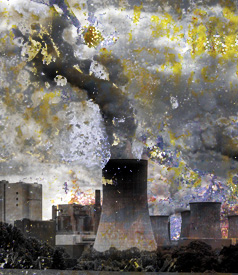The Environmental Protection Agency (EPA) has severely underreported the severity of coal ash waste pollution and its threat to human and environmental health throughout the United States, a new independent study released February 24 by the Environmental Integrity Project (EIP) and Earthjustice says.
The EPA’s tally of coal ash contamination locations last year did not include an additional 31 sites that should have been included in the totals, stated the study, entitled “Out of Control: Mounting Damages From Coast Ash Waste Sites.”
Annually, coal-fired power plants in the US produce approximately 140 million tons of fly ash, scrubber sludge and additional combustion waste from the burning of the fossil fuel. This coal ash, which contains numerous toxins like arsenic and lead, is contaminating groundwater, drinking supplies and wetlands in dozens of states.
Using a similar methodology as the EPA to identify these sites, Earthjustice and EIP found that since the EPA’s coal waste list is missing 31 toxic areas, the agency is failing to allow the public to fully understand the gravity of the problem. The Obama administration’s Office of Management and Budget (OMB) is reviewing a coal-ash contamination rule proposed by the EPA, but despite mounting pressure from environmental groups OMB has not yet allowed the EPA to monitor coal waste.
“At 15 of the 31 sites, contamination has already migrated off the power plant property (off-site) at levels that exceed drinking water or surface water quality standards,” authors of the report contend. “The remaining 16 show evidence of severe on-site pollution. Because off-site monitoring data at 14 of these 16 sites were not available, damage may be more severe and widespread than indicated in this report.”
In all, 14 states were mentioned as having coal waste sites that are not currently listed as polluted by the EPA. The report also noted that these unregulated areas pose “clear and present danger” to nearby communities.
The coal industry and some members of Congress do not want to see coal ash deemed a toxic material for fear that it will affect the way coal-fired power plants operate, inevitably hurting the company’s bottom line as well as jobs in their respective states.
On February 4, 2010, six members of the Illinois Congressional delegation, led by Democrat Jerry Costello and Republican John Shimkus, sent a letter to the OMB urging it not to give the EPA authority to regulate coal waste.
“[R]egulating [combustion by-products] as hazardous waste will impose steep costs on Illinois energy consumers while producing little environmental benefit beyond what can be achieved through non-hazardous waste authority,” the letter stated. “Hazardous waste regulation will require significant engineering changes, capital expenditures, and operating costs. These costs will be passed to consumers, increasing utility bills in a difficult economic climate.”
However, environmentalists counter that without regulating coal waste, companies will continue to operate with impunity. Last year’s spill at the Tennessee Valley Authority’s (TVA) Kingston plant, where 1 billion gallons of sludge destroyed countless homes and poisoned drinking water in several communities, is often cited as a prime example of what can happen when these sites go unregulated.
“While the catastrophic spill at TVA’s Kingston plant has become the poster child for the damage that coal ash can wreak, there are hundreds of leaking sites throughout the United States where the damage is deadly, but far less conspicuous,” said Jeff Stant of the EIP, said in a statement released along with the report.
Additionally, the EPA acknowledges that most coal ash ponds and many coal waste landfills are unlined and unregulated. As such, authors of the report argue, the EPA cannot adequately assess the amount of contamination these ash dumps are contributing to groundwater supplies.
“Water sources contaminated by coal ash may eventually be cleaned up, but only at great expense and over long periods of time,” Earthjustice and EIP write in their joint study. “Injury to human health or wildlife, however, cannot always be reversed. The evidence is overwhelming – these 31 sites sound a clear warning that the EPA must heed before more damage is done.”
Join us in defending the truth before it’s too late
The future of independent journalism is uncertain, and the consequences of losing it are too grave to ignore. To ensure Truthout remains safe, strong, and free, we need to raise $47,000 in the next 8 days. Every dollar raised goes directly toward the costs of producing news you can trust.
Please give what you can — because by supporting us with a tax-deductible donation, you’re not just preserving a source of news, you’re helping to safeguard what’s left of our democracy.
